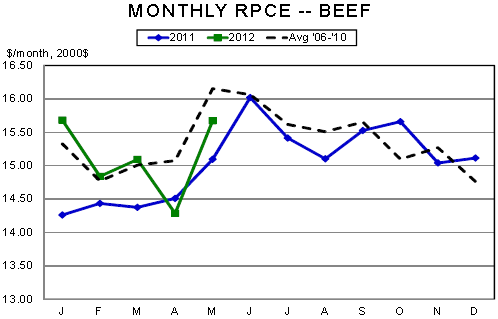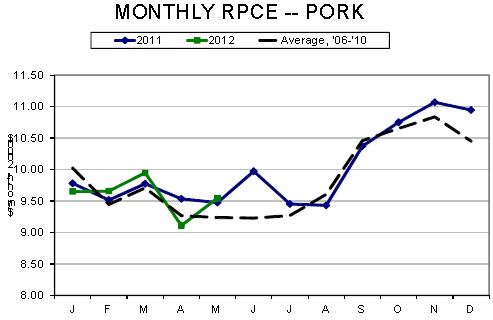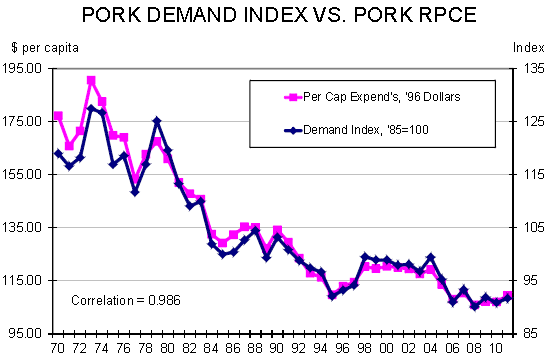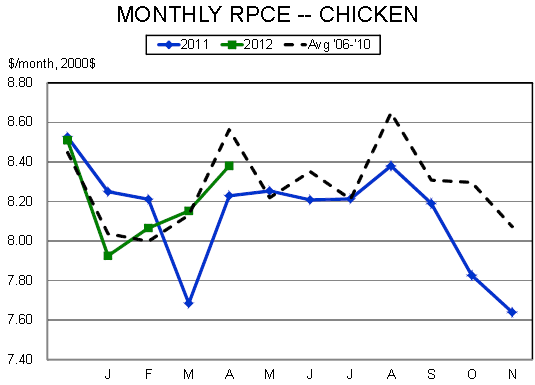



CME: Beef, Pork and Chicken RPCE Demand
US - “Demand is the problem!“ is a declaration we hear often when meat prices falter. Sometimes the statement is true and sometimes it is not. One challenge is that the validity of the statement is very difficult to check in real time because sufficient data are not available, write Steve Meyer and Len Steiner.Complete data for per capita consumption is
available only two months in arrears since, as readers of this letter
know, consumption is a function of production and exports/imports
and the export/import data run two months behind. About the best
we can do without using export/import forecasts or predictions is to
measure the status of demand two months ago.
But even with those data, the question of measuring demand
is not completely clear and is muddied by misuse of the term
demand. Some claim “demand is good“ when large quantities of
product are moving without regard for the prevailing price level. Or
conversely, they say something like “high prices have reduced demand“
— a statement that is equally incorrect. Demand is not
quantity. It is the set of quantities of a product that consumers are
willing and able to purchase at alternative prices — an entire group
of price-quantity combinations that define the demand curve in a
classic supply-demand diagram. Our goal has always been to use a
measure that includes both price and quantity and thus tells us
something about the position of the demand curve in the standard
quantity-price space of the supply-demand diagram we learned in
Econ 101 or its equivalent course at your favorite university.
Our tool of choice for that comparison has long been the
demand index first used by Professor Glenn Grimes at the University
of Missouri. This index puts the position of the demand curve in
Q-P space in terms of a base year and thus measures its movement
by the difference between the index levels each year. An
increase in the index means the demand curve has moved up and
to the right. A decrease means just the opposite. The index does
not explain why demand changes. It only states how much it
changes. A complete explanation of index computations, written by
Dr Ron Plain, a long-time colleague of Professor Grimes at Mizzou,
can be found at agebb.missouri.edu/mkt/demand/index.htm.
The data used in the demand index calculations are per
capita consumption, nominal retail price, a measure of inflation (the
CPI for all goods, in this case) and an assumed elasticity of demand.
The first three of these can be used to simply compute real
per capita expenditures (per capita consumption x deflated retail
price) or RPCE. Embedded in the year-on-year change in RPCE is
the actual negative relationship between price and quantity — or
the elasticity of demand.
Are the two measures similar? As can be seen below,
they are, historically, practically identical for pork. The same is true
for both beef and chicken. The only source of difference would be
variation between the assumed elasticity used in the index calculations
(here it is –0.75) and the actual elasticity exhibited by consumer
purchase decisions.
So how can this information be used? Charts of monthly
RPCE for beef and pork appear below. The chicken chart is also below.




The impact of the “pink slime“ smear campaign is very
clear in the beef chart as RPCE dipped sharply in April. The good
news is that it recovered in May to a level 3.8 per cent higher than one
year ago. RPCE for beef is up 4 per cent year-to-date and, for the past 12
months, is 3.4 per cent higher than the same period (June-May) one year
earlier. We believe the latter comparison is the most valid since it
includes an entire year of seasonal variation where year-to-date
comparisons do not do so until we get to December.
As we expected, pork demand appears to have been hurt
by the LFTB situation as well. It, too rebounded in May to move
slightly above the 2011 level. Pork RPCE (demand) is down 0.4 per cent
from one year earlier over the past 12 months.
Finally, chicken RPCE (demand) continued to
recover from its abysmal February level but remains 2.7 per cent lower
than one year earlier over the past 12 months.






